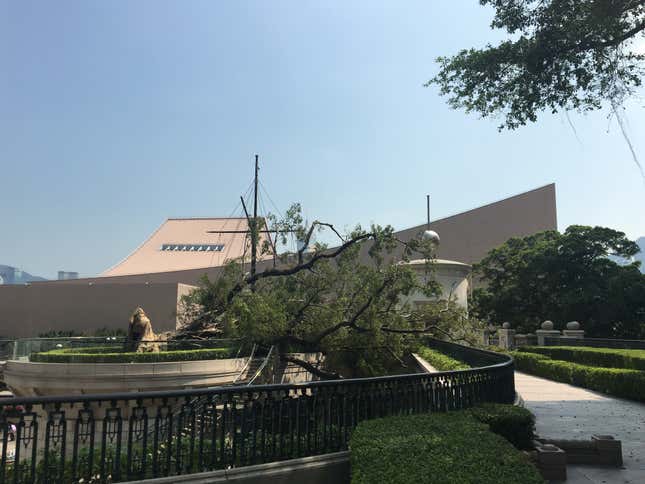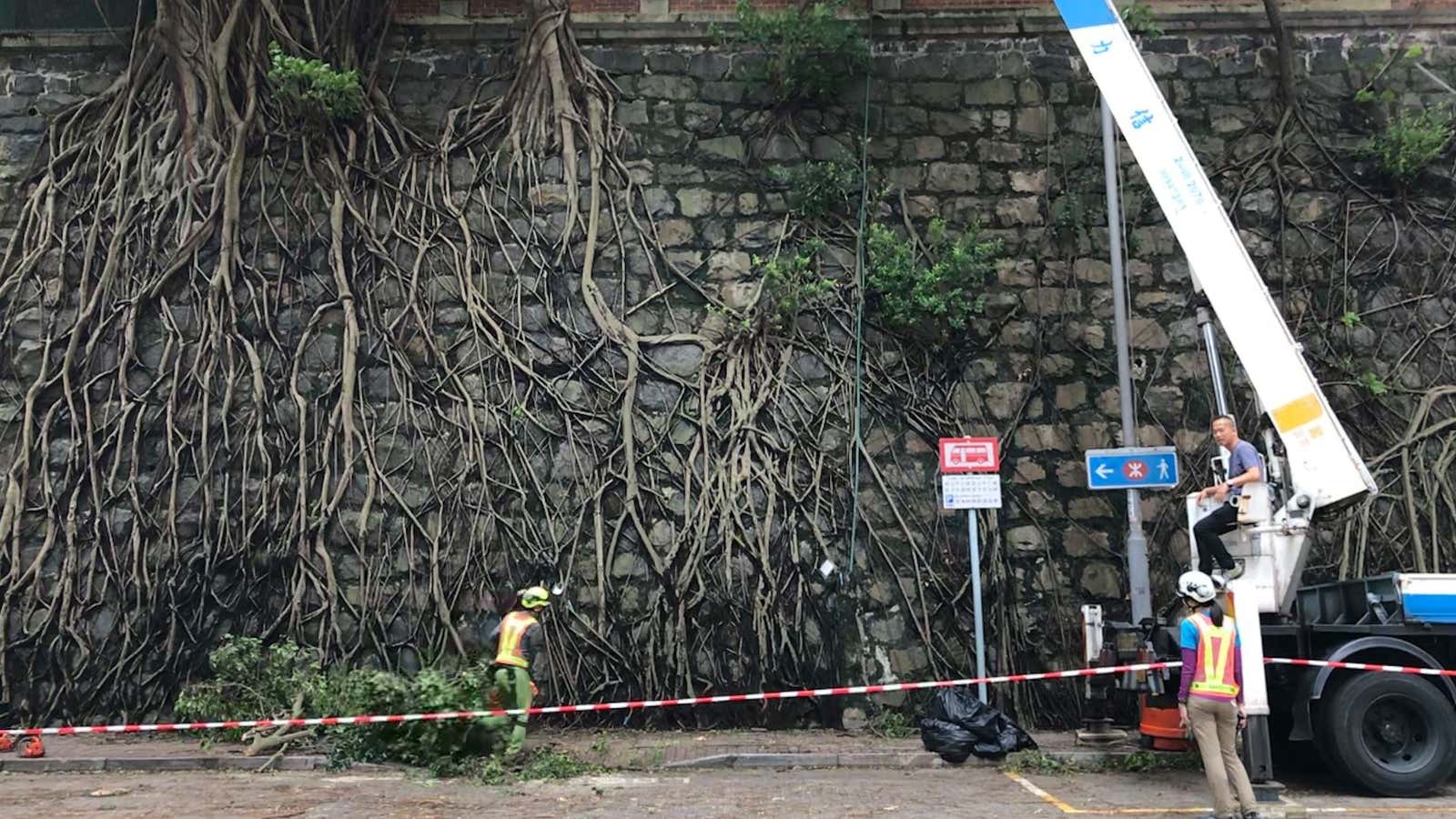As Typhoon Mangkhut slammed Hong Kong last weekend (Sept. 16), it left a trail of destruction in its wake. Not only did it break windows, wash away roads, and crumple scaffolding, but it also destroyed thousands of trees that are a crucial part of the city’s history and identity.
“It’s an unprecedented number of trees that’s been toppled by the typhoon,” said Alvin Tang, a certified arborist and a lecturer on tree management at the Baptist University of Hong Kong.
Among those are the large and majestic banyan trees found all around Hong Kong, including a century-old giant located at a hotel and luxury mall called 1881 Heritage, in Hong Kong’s upscale Tsim Sha Tsui district by Victoria Harbour.
That tree is now lying on its side adjacent to a signal tower that used to send signals to ships in the harbor, with its roots in the air. Workers have covered up the tree roots with dampened hessian, a woven fabric also known as burlap that is often to make sacks, in a bid to protect it.
Making way for malls
Ken So, chief executive of the Conservancy Association, a non-profit group, said that when he inspected the tree this week, the upturned root-plate was made up mostly of small roots, with large supporting roots nowhere to be seen. A large branch had also been crushed under the weight of the tree.

“We have to closely examine why the roots are so shallow,” said So. “Is it a problem with the soil or with watering? These are all very basic factors that need to be addressed.” He thinks that with some work, the tree can be put upright again. “I did not see signs of damage that would suggest that the tree cannot be saved.”
Still, So said, there’s a reason why the tree has fallen to this sorry state, unable to support its weight under the barrage of Mangkhut.
The location of 1881 Heritage used to be a grassy knoll at the tip of the Kowloon Peninsula, but much of the hill was excavated away during construction of the luxury complex. The redevelopment of the site, which housed the former marine police headquarters of the British colonial government, also involved the axing of nearly 150 trees to make way for the hotel and mall. Several trees—including the fallen historic banyan—were saved and replanted, but the traumatic procedure likely harmed their long-term health.
“The tree used to have a mountain full of soil, but now it only has a mound” and is encased in a concrete shell, severely restricting its access to high quality soil and its ability to tap water from wider underground sources, said So.
When he went to check on the tree several months ago, he found that it had less than a third of the leaves than before its replanting, So told the South China Morning Post.
Symbols of resilience
Hong Kong’s banyan trees are an integral part of the city’s fabric. In addition to parks, they also line streets like Nathan Road, a busy thoroughfare running through some one of the densest areas of the Kowloon area, serving as an important source of shade in a city where temperatures can reach 36.6° C (98° F).
The Chinese banyan, or ficus microcarpa, is a large evergreen tree native to southern China and tropical parts of Asia. There is no official count of the exact number of banyans in Hong Kong, but one expert (paywall) has put the estimate at over 7,100. The hardy, fast-growing tree can live for centuries and can grow almost anywhere it settles, including between cracks in concrete or in the crotch of other trees, serving as symbols of resilience and resourcefulness.
“If Hong Kong was abandoned it would be taken over by banyans in a few hundred years,” Jim Chi-yung, an experts on trees at the Education University of Hong Kong, told Zolima Citymag.
But trees in the city also have to deal with less-than-ideal conditions. Hong Kong’s steep topography, high population density, and a lack of plantable space makes its trees vulnerable to strong winds and rain. Add to this the fact that all urban areas in Hong Kong are squeezed into (pdf) a mere 24% of available land, of which a majority are on terraced slopes, and it quickly becomes apparent that trees do not have it easy here.
“Urban trees in Hong Kong exist in stressful and harsh habitat conditions due mainly to the exceptionally high-density development mode,” wrote Jim in a paper on heritage trees in Hong Kong.
Then there are the challenges of roadwork and construction, which severs tree roots and make them prone to collapse during storms. Excessive concrete paving around the city also weakens trees by sealing off the soil near the trunk base, cutting off water and air supply to the roots.
To study the trees of Hong Kong is to trace the city’s history through the decades.
“Urban forestry history in Hong Kong has echoed the fluctuating fortunes of the city,” Jim wrote in another paper. “In the embryonic days over a century ago, the pressure on maximizing land use was not that acute.” Then came the post-war period, which saw rapid population growth and intensifying development, with conditions for trees deteriorating dramatically in the 1960s and 1970s before a realization in the 1980s and 1990s that the city needed to be beautiful and liveable.
The banyans also tell a story of the push and pull between the city’s residents and the government, and between seemingly contesting goals of conservation and development.
In 2015, the Highways Department, without prior announcement, suddenly chopped down four century-old banyans on Bonham Road in the western district of Hong Kong Island—which has one of the highest concentrations of old and valuable trees in the city—after another banyan nearby collapsed due to heavy rain. Residents were outraged, and experts deemed it an overreaction on the government’s part, but officials insisted that the trees had to go for the sake of public safety.
The city’s urban forestry history now has a new chapter: the destruction of trees at the hands of the fiercest storm to hit Hong Kong yet.
